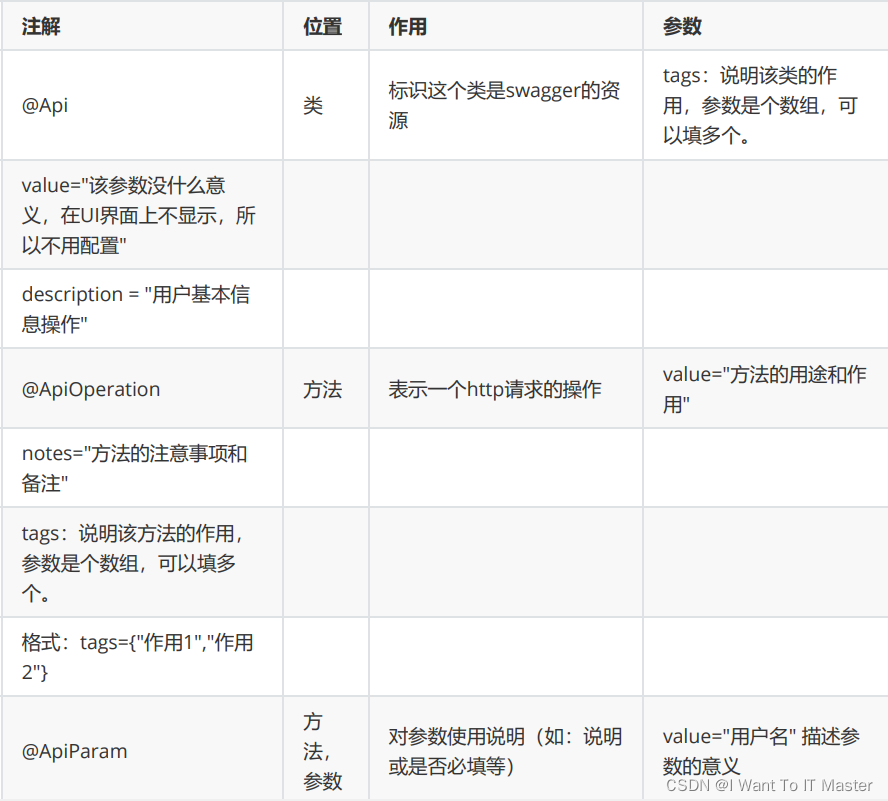目录
? ? ? ? ? ? ? ? 2.1. 打开https://mvnrepository.com/ , 查找springbox,在pom.xml中导入如下图标出的依赖。
? ? ? ? ? ? ? ? 2.3. 编写swagger的配置类
一、Swagger介绍
1、定义:
Swagger 是一个规范和完整的框架,用于生成、描述、调用和可视化 RESTful 风格的 Web 服务。总体目标是使客户端和文件系统作为服务器以同样的速度来更新。文件的方法,参数和模型紧密集成到服务器端的代码,允许API来始终保持同步。
2、为什么会用到Swagger
前后端分离是的前端与后端之间的职责更加明确后台: 负责业务处理前端: 负责显示逻辑在这种情况下,前端和后端可以分别交付给专业的开发人员去做,所以是必须要定义前后端直接的对接接口,否则各自为是则项目无法集成,这时就需要一个文档来定义统一的接口。
但是:在没有swagger之前
我们可以使用word,excel等功能来书写接口定义文档,但又有一个弊端,即:在接口发送改变时需要及时的同步接口文档,否则实际的接口与接口文档不相符,则接口文件就失去了作用,甚至会起到反作用。所以就诞生了Swagger
3、Swagger作用
根据在代码中使用自定义的注解来生成接口文档,这个在前后端分离的项目中很重要。这样做的好处是在开发接口时可以通过swagger将接口文档定义好,同时也方便以后的维护。
????????
4、Swagger优点
根据在代码中使用自定义的注解来生成接口文档,这个在前后端分离的项目中很重要。这样做的好处是在开发接口时可以通过swagger将接口文档定义好,同时也方便以后的维护。
二、集成Swagger
? ? ? ?1、新建springboot项目

? ? ? ?2、集成swagger?
? ? ? ? ? ? ? ? 2.1. 打开https://mvnrepository.com/ , 查找springbox,在pom.xml中导入如下图标出的依赖。
前一俩个依赖都需要:?

? ? ? ? ? ? ? ? 2.2. 导入依赖
<dependency>
<groupId>io.springfox</groupId>
<artifactId>springfox-swagger2</artifactId>
<version>2.9.2</version>
</dependency>
<dependency>
<groupId>io.springfox</groupId>
<artifactId>springfox-swagger-ui</artifactId>
<version>2.9.2</version>
</dependency>? ? ? ? ? ? ? ? 2.3. 编写swagger的配置类
package com.example.swagger01.config;
import org.springframework.context.annotation.Bean;
import org.springframework.context.annotation.Configuration;
import springfox.documentation.builders.ApiInfoBuilder;
import springfox.documentation.builders.PathSelectors;
import springfox.documentation.builders.RequestHandlerSelectors;
import springfox.documentation.service.ApiInfo;
import springfox.documentation.spi.DocumentationType;
import springfox.documentation.spring.web.plugins.Docket;
import springfox.documentation.swagger2.annotations.EnableSwagger2;
@Configuration
@EnableSwagger2
public class SwaggerConfig {
@Bean
public Docket createRestApi() {
return new Docket(DocumentationType.SWAGGER_2).apiInfo(apiInfo())
.select()
.apis(RequestHandlerSelectors.any())
.paths(PathSelectors.any())
.build();
}
private ApiInfo apiInfo() {
return new ApiInfoBuilder()
.title("SwaggerDemo API DOC")
.description("SwaggerDemo API DOC")
.version("1.0")
.termsOfServiceUrl("https://www.baidu.com")
.build();
}
}
注意: 该配置类需要根据自己的项目修改,如以下配置paths 指定需要生成文档的url规则title 文档标题description 描述
? ? ? ?3、开发一个controller用于测试
package com.example.swagger01.controller;
import com.example.swagger01.pojo.User;
import com.example.swagger01.response.ResponseResult;
import io.swagger.annotations.*;
import org.springframework.web.bind.annotation.*;
@RestController
@RequestMapping("/swaggerdemo")
@Api(tags = "控制类")
public class HelloController {
@ApiOperation(value = "欢迎信息")
@GetMapping("/hello")
@ApiImplicitParams({
@ApiImplicitParam(name = "name", value = "名称", dataType = "string", paramType = "query", required = true),
@ApiImplicitParam(name = "msg", value = "消息", dataType = "string", paramType = "query", required = true)
})
public ResponseResult<?> hello(String name, String msg) {
return ResponseResult.success();
}
@PostMapping("/register")
@ApiOperation("注册用户接口")
@ApiResponses({
@ApiResponse(code = 10001, message = "Exception 01"),
@ApiResponse(code = 10002, message = "Exception 02"),
@ApiResponse(code = 10003, message = "Exception 03")
})
public ResponseResult<?> register(@RequestBody User user) {
return ResponseResult.success();
}
@PutMapping("/edit")
@ApiOperation("修改用户信息")
public ResponseResult<?> edit(User user) {
return ResponseResult.success();
}
@DeleteMapping("/delete/{id}")
@ApiOperation("删除用户")
@ApiImplicitParam(name = "id", value = "用户ID", dataType = "string", paramType = "path", required = true)
public ResponseResult<?> delete(@PathVariable("id") String id) {
return ResponseResult.success();
}
}
? ? ? ?4、启动服务,验证集成效果
服务启动后,访问:http://localhost:8080/swagger-ui.html

三、Swagger常用注解
? ? ? ? 1、常用注解如下

?
?
header 请求参数的获取:@RequestHeader
query ?请求参数的获取:@RequestParam
path(用于restful接口) 请求参数的获取:@PathVariable
body(不常用)
form(不常用)?
?defaultValue="参数的默认值"required="true" 表示参数是否必须传 |
?因为swagger是一个在线生成接口文档,所以我们可以进行测试

这个注解是在类上面进行注释的,可以说明这个类是什么类
?
测试完了类,接下来测试实体类的属性

 ?进行发送请求:
?进行发送请求:

?发送成功!
今天的知识就分享到这了,希望能够帮助到你!